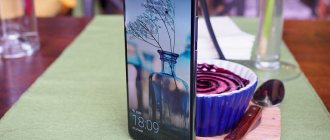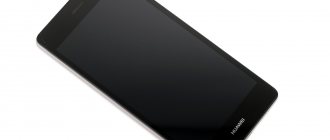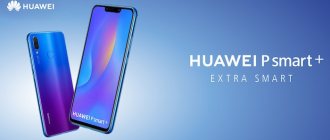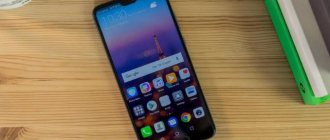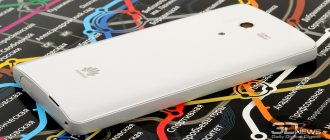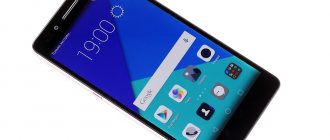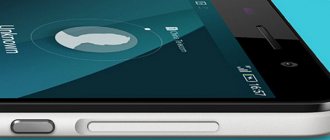Yes, Huawei partially creates this excitement on its own – everyone is still far from Apple, which launches a flywheel of frenzy on social networks simply by the very fact of announcing anything. But smartphones produced by the Chinese company no longer look like just discount options for those who want to get a top-end gadget for little money, but quite equal competitors to devices from Korean, Japanese and American brands. At the beginning of the year we talked about the “large” flagship Mate 8, which had just reached the Russian market, but now we will talk about the flagship of “standard” sizes, the successor to the Huawei P8. We already published a short preliminary review of this model on the day of its announcement, now we offer you full testing.
Huawei P9 in its natural habitat
With its thin metal body, rear-mounted fingerprint scanner, Kirin 955 platform and almost bezel-less LCD display, the Huawei P9 really looks like a slightly smaller version of the Mate 8 - if not for the dual camera created in collaboration with Leica. The pride, beauty and zest of the new Huawei flagship, which caused a lot of gossip. What does Leica have to do with it? Why two sensors and two lenses at once? Is it really no worse than the iPhone? We answer these and many other questions related to P9.
⇡#Technical characteristics
| Huawei P9 | Huawei P8 | Samsung GALAXY S7 | Google Nexus 5X | Moto x Force | |
| Display | 5.2 inches, IPS, 1920 × 1080 pixels, 424 ppi, capacitive multi-touch | 5.2 inches, IPS, 1920 × 1080 pixels, 424 ppi, capacitive multi-touch | 5.1 inches, AMOLED, 2560 × 1440 pixels, 575.9 ppi, capacitive multi-touch | 5.2 inches, IPS, 1920 × 1080 pixels, 424 ppi, capacitive multi-touch | 5.4 inches, pOLED, 2560 × 1440 pixels, 540 ppi, capacitive multi-touch |
| Air gap | No | No | No | No | No |
| Protective glass | Corning Gorilla Glass 4 | Corning Gorilla Glass 3 | Corning Gorilla Glass (version not specified) on both sides | Corning Gorilla Glass 3 | Corning Gorilla Glass 3 |
| CPU | Huawei Kirin 955 (four ARM Cortex-A72 cores, 2.5 GHz; four ARM Cortex-A53 cores, 1.8 GHz) | Huawei Kirin 930 (four ARM Cortex-A53 cores, 2.0 GHz; four ARM Cortex-A53 cores, 1.5 GHz) | Exynos 8890 Octa (four ARM Cortex-A57 cores, 2.6 GHz; four ARM Cortex-A53 cores, 1.6 GHz) | Qualcomm Snapdragon 808 (four ARM Cortex-A53 cores, 1.4 GHz + two ARM Cortex-A57 cores, 1.82 GHz) | Qualcomm Snapdragon 810 (four ARM Cortex-A57 cores, 2 GHz + four ARM Cortex-A53 cores, 1.5 GHz) |
| Graphics controller | Mali-T880 MP4, 900 MHz | ARM Mali-T628 MP4, 600 MHz | Mali-T880 MP12, 650 MHz | Adreno 418, 600 MHz | Adreno 430, 650 MHz |
| RAM | 3/4 GB | 3 GB | 4 GB | 2 GB | 3 GB |
| Flash memory | 32/64 GB | 16/64 GB | 32/64 GB | 16/32 GB | 32 GB |
| Memory card support | Eat | Eat | There is, in the S7 Duos version, a combined slot for a memory card and SIM card | No | Eat |
| Connectors | USB Type-C, 3.5 mm minijack | microUSB, 3.5 mm minijack | microUSB, 3.5 mm minijack | USB Type-C, 3.5 mm minijack | microUSB, 3.5 mm minijack |
| SIM cards | One nanoSIM/two nanoSIM | One nanoSIM | One nanoSIM/two nanoSIM | One nanoSIM | One nanoSIM |
| Cellular connection 2G | GSM 850 / 900 / 1800 / 1900 MHz | GSM 850 / 900 / 1800 / 1900 MHz | GSM 850 / 900 / 1800 / 1900 MHz | GSM 850 / 900 / 1800 / 1900 MHz | GSM 850 / 900 / 1800 / 1900 MHz |
| Cellular 3G | HSDPA 800/850/900/1700/1800/1900/2100 | HSDPA 800/850/900/1700/1800/1900/2100 | HSPA 850/900/1700/1900/2100 MHz | HSDPA 800/850/900/1700/1800/1900/2100 | UMTS/HSPA+ 850, 900, 1700, 1900, 2100 MHz |
| Cellular 4G | LTE Cat. 6 (up to 300 Mbit/s): bands 1, 2, 3, 4, 5, 6, 7, 8, 12, 17, 18, 19, 20, 26, 28, 38, 39, 40 | LTE Cat. 6 (up to 300 Mbit/s): bands 1, 2, 3, 4, 5, 7, 8, 12, 17, 18, 19, 20, 25, 26, 28, 40 | LTE Cat support. 12 (up to 600/50 Mbit/s): bands 1, 2, 3, 4, 5, 7, 12, 13, 20 | LTE Cat. 6 (up to 300 Mbit/s): bands 1, 2, 3, 4, 5, 7, 8, 9, 17, 18, 19, 20, 26, 28, 38, 39, 40, 41 | FDD LTE Cat. 6 (up to 300 Mbit/s): bands 1, 2, 3, 4, 5, 7, 8, 12, 17, 20, 25, 28, 40 |
| WiFi | 802.11a/b/g/n/ac | 802.11a/b/g/n | 802.11a/b/g/n/ac | 802.11a/b/g/n/ac | 802.11a/b/g/n/ac |
| Bluetooth | 4.2 | 4.1 | 4.2 | 4.2 | 4.1 |
| NFC | Eat* | Eat | Eat | Eat | Eat |
| Navigation | GPS, A-GPS, GLONASS, BeiDou | GPS, A-GPS, GLONASS, BeiDou | GPS, A-GPS, GLONASS, BeiDou | GPS, A-GPS, GLONASS | GPS, A-GPS, GLONASS |
| Sensors | Illumination, proximity, accelerometer/gyroscope, magnetometer (digital compass) | Illumination, proximity, accelerometer/gyroscope, magnetometer (digital compass) | Illumination, proximity, accelerometer/gyroscope, magnetometer (digital compass), barometer, heart rate | Illumination, proximity, accelerometer/gyroscope, magnetometer (digital compass), barometer, pedometer | Illumination, proximity, accelerometer/gyroscope, magnetometer (digital compass) |
| Fingerprint's scanner | Eat | No | Eat | Eat | No |
| Main camera | Leica, dual module, 12 megapixels, f/2.2, phase detection autofocus, LED flash, 4K video recording | 13 MP, ƒ/2.0, LED flash, Full HD video recording | 12 MP, ƒ/1.7, phase detection autofocus, LED flash, optical stabilization, 4K video recording | 13 MP, ƒ/2.0, laser autofocus, LED flash, 4K video recording | 21 MP, ƒ/2.0, phase detection autofocus, LED flash, Full HD video recording |
| Front-camera | 8 MP, fixed focus | 8 MP, fixed focus | 5 MP, fixed focus | 5 MP, fixed focus | 5 MP, fixed focus |
| Nutrition | Non-removable 11.4 Wh battery (3000 mAh, 3.8 V) | Non-removable 10.18 Wh battery (2680 mAh, 3.8 V) | Non-removable 11.4 Wh battery (3000 mAh, 3.8 V) | Non-removable 10.26 Wh battery (2700 mAh, 3.8 V) | Removable 14.2 Wh battery (3760 mAh, 3.8 V) |
| Size | 145 × 70.9 × 7 mm | 144.9 × 72.1 × 6.4 mm | 142.4 × 69.6 × 7.9 mm | 147 × 72.6 × 7.9 mm | 149.8 × 78 × 9.2 mm |
| Weight | 144 grams | 144 grams | 152 grams | 136 grams | 169 grams |
| Housing protection | No | No | IP68 Up to half an hour at a depth of up to 1.5 m | No | ShutterShield |
| operating system | Android 6.0 Marshmallow, own EMUI 4.1 shell | Android 6.0 Marshmallow, own EMUI shell | Android 6.0 Marshmallow, Samsung's own TouchWiz shell | Android 6.0 Marshmallow | Android 6.0 Marshmallow |
| Current price | Approximately 50,000 rubles | 30,000 rubles | from 49,990 rubles | 25,000-34,000 rubles (depending on memory capacity) | 49,990 rubles |
*only in version with one SIM card
| Huawei P9 – information about the filling according to the CPU-Z application | ||
Battery
With battery and autonomy it was almost a draw. Under the hood, the P smart 2021 houses a massive 5000mAh battery. Depending on the load, the phone can work from 1 to 3 days on a single charge. Such good autonomy is ensured by built-in energy-saving functions and a not too power-hungry processor.
The 22.5 W power adapter recharges the P smart in approximately 100 minutes. In half an hour, the charge percentage increases from 0 to 45. RedmiNote 9 Pro gains energy a little faster: 60% in half an hour or 100% in 70 minutes. Because the included charger is 33 W.
The battery life of a Xiaomi smartphone also reaches 2-3 days (in low-key mode), but it can last 9-10 hours if you try hard with games.
| Huawei P smart 2021 | Xiaomi RedmiNote 9 Pro | |
| Battery capacity | 5000 mAh (min. 4900) | 5020 mAh |
| Fast charging | 22.5 W | 30 W (33 W charger included) |
| Connector | USB-C 2.0, OTG | USB-C 2.0, OTG |
⇡#Appearance and ergonomics
This is how Huawei P9 looks in the hand.
Huawei has finally given up on experimentation and is consistently introducing its signature style with a flat back and a front panel devoid of hardware keys, where almost all the space is occupied by an almost frameless display, and the obligatory signature is displayed under it. It won’t be difficult to find something in common between the P9 and, for example, the iPhone - just look at the bottom edge with similar screws and a speaker grille. But we are talking about modern smartphones - gadgets that are so unified and tailored to a specific use case that they have more similarities than differences. Be that as it may, the P9, with its thin metal body and the camera that does not protrude above it, looks very elegant and beautiful - people who paid 50-60 thousand rubles for a gadget will definitely not be ashamed of it.
Huawei P9, front panel: above the display there is a speaker with a status indicator inscribed in its grille, a front camera and a light sensor
Huawei P9, rear panel: at the top there are two camera lenses with dual LED flash and laser autofocus, below there is a fingerprint scanner
The smartphone is offered in six colors: Haze Gold, Rose Gold, Prestige Gold, Ceramic White, Titanium Gray, Mystic Silver. Three golden variations at once - I think the Middle East and China will be happy. Perhaps the most interesting design is Ceramic White, with the actual use of ceramics covered with layers of glass. We are testing the Mystic Silver version. Black P9 does not exist in nature - another hello iPhone.
Huawei P9, top edge: microphone hole only
Huawei P9, bottom edge: mini-jack (3.5 mm) for headphones/headsets, conversational microphone, USB Type-C port, speaker
Dimensions Huawei P9 – 145 × 70.9 × 7 mm, weight – 144 grams. This is one of the thinnest and lightest flagship smartphones. The P9 is only half a millimeter thicker than the P8 and a good millimeter thinner than, for example, the Samsung Galaxy S7 or the standard Google Nexus 5X in terms of convenience. A 5.2-inch display is the required minimum by today's standards. Well, the almost complete absence of frames turns the P9 into a very compact and easy-to-use gadget. You can operate it with one hand without the slightest difficulty.
Huawei P9, right side: standard set of volume key and power key located below it
Huawei P9, left side: single slot for nanoSIM card and microSD card
Among the controls, we highlight the power button, slightly recessed into the body. Its surface is embossed, but its texture differs from the volume key. It would seem that there shouldn’t be a problem with recognizing keys of different sizes by touch, but now there certainly is.
Huawei P9, fingerprint scanner
The fingerprint scanner has again become square, versus the round one of the Mate 8. It is located on the back and is not as easy to access as combined with the Home key on the same Samsung Galaxy S7, iPhone or HTC 10. But in the absence of a physical key on the faceplate, this is the sweet spot. Definitely more convenient - due to the larger area - than the side panel, like on the Sony Xperia Z5.
Huawei promises an adaptive scanner mechanism and record finger recognition time - and I had the opportunity to test the system in harsh conditions. The fact is that during testing I slightly cut my finger - and this caused difficulties for the scanner. On the first try he almost never succeeded in recognizing the fingerprint, but on the second or third he coped with the task. However, he failed to adapt to the new conditions. In such cases, I recommend that you simply go through the fingerprint memorization procedure again - fortunately, it is elementary.
Huawei P9 Plus
For those to whom the 5.1-inch display still seems like a relic of the dark times of small smartphones, there is a version of the P9 Plus with a 5.5-inch AMOLED display, which, in addition, differs only in a larger battery, an improved front camera with autofocus and Press Touch technology in the display.
⇡#Software
Huawei P9 runs Android 6.0 Marshmallow, covered with Emotion UI 4.1 shell. We talked about it in more detail (albeit in version 4.0) in the review of Huawei Mate 8, here we’ll just remind you of its main features.
The shell is built on the iOS principle - without a list of applications, all icons are laid out on an endless list of screens with the ability to group them thematically. The notification menu looks unusual, but you get used to it so easily that it’s quite difficult to “switch back” to the standard Android mechanisms.
It's a great-looking, easy-to-use shell that boasts several unusual features, such as Knuckle Sense 2.0, which allows you to take screenshots, capture a specific area of the screen, take a “long screenshot” of an entire document spanning multiple screens, and jump to specific applications by drawing the corresponding symbol with knuckles. This is a function that few people need, but it is a mandatory function for self-identification of the shell - Emotion UI must somehow stand out from its peers. But recording videos (screencasts) from the screen and the multi-window mode, while not unique, are noticeably more useful to the average user. By the way, this same multi-window feature will appear in the next version of Android, but for now it is the different shells that allow us to look into the future.
The only small complaint we can make against EMUI on the P9 is the excessive number of pre-installed applications. However, no one is stopping you from removing the excess.
⇡#Display
Huawei P9 with display enabled
Huawei has consistently avoided the Quad HD displays that have become the norm for other flagships since last year, equipping all its new models with screens with a resolution of 1920 × 1080. This may seem a little strange, but only from a marketing point of view - noticeable to the naked eye It is almost impossible to see a difference in a picture with a pixel density of over 400 ppi. Even using the six-inch Mate 8 with the same resolution, I did not experience the slightest discomfort, let alone the 5.2-inch or 5.5-inch displays (Plus version). The advantages of this solution are obvious: there are fewer performance requirements and, as a result, less power consumption. The disadvantages are essentially only reputational ones.
But the fact that AMOLED is used only in the Plus version, and the regular one is equipped with an LCD display, is still a little sad: for all the charm of high-quality IPS matrices, in terms of contrast level and, as a result, the saturation and depth of the picture, they are up to the matrices those based on organic light-emitting diodes fall short.
The touch surface is capacitive and recognizes up to 10 simultaneous clicks. You can operate with gloves by turning on the special mode - it is enough to answer the challenge without much comfort.
The display on the Huawei P9 may seem identical to that of last year's P8, but it's actually different. For the most part - for the better. In particular, it is noticeably brighter - up to 494 cd/m2 with a minimum brightness of 29 cd/m2 in the same mode. A very nice plug, which means that the smartphone is comfortable to use both in the sun and in the dark, especially considering the presence of a mandatory polarizing filter and the absence of an air gap.
The minimum black field luminosity is 0.37 cd/m2, which is quite decent for an LCD display. The contrast measured on the “checkerboard” is 1100:1 - this is not an outstanding result for LCD displays in the upper price range, but the advantage over the P8 is noticeable - last year’s flagship had a contrast value of 972:1. There is no need to talk about competition with AMOLED displays, like those on the Samsung Galaxy S7 or Moto X Force, which have a conditionally infinite contrast level.
Huawei P9, gamma. Yellow line – P9 indicators, dotted line – reference gamma
Huawei P9, color gamut. Gray triangle – sRGB coverage, white triangle – P9 coverage
The average gamma for shades of gray is 2.27, quite within normal limits. But the average DeltaE deviation according to the Color Checker test (taking into account both shades of gray and a wide color palette) was 6.58, this is a weak result - the screen in standard mode is not configured very carefully. Pay attention to the color gamut, which significantly exceeds the sRGB standards - this is the explanation for the deviations.
Huawei P9, color temperature. Blue line – P9 indicators, dotted line – reference temperature
The color temperature is noticeably “colder” than the norm - it fluctuates around 8500 K, while the norm is 6500 K. However, this can be corrected in the display settings - the temperature can be adjusted manually, which I recommend doing immediately after purchasing the device.
Huawei P9, display settings
Viewing angles are traditionally large for high-quality IPS - with a reasonable deviation from the perpendicular, colors are practically not distorted, and contrast drops moderately.
Screen
Both smartphones have a capacitive touchscreen with curved edges. It is small but quite clear.
The Huawei Y5p smartphone has a bright TFT LCD (IPS) screen with a screen diagonal of 5.45 inches, resolution – HD+ 1440×720 pixels, PPI – 295.4. The Honor 9S also has a screen diagonal of 5.45 inches, a resolution of 720 by 1440, an aspect ratio of 18:9, and a PPI of 295.4. The screen matrix is covered with protective glass.
The screen fades quite a bit in bright sunlight, the viewing angles are not very great, but in general, for such budget smartphones this is not a bad screen at all.
| Huawei Y5p | Honor 9S | |
| Diagonal | 5.45 inches | 5.45 inches |
| Permission | 720×1440 | 720×1440 |
| Matrix | TFT LCD (IPS) | — |
⇡#Hardware and performance
Huawei P9, Antutu 6.0.1 benchmark results
Huawei has not retreated from the practice of using platforms of its own production: having been burned in the past, the Chinese company has drawn conclusions and by this year has prepared much more competitive systems-on-a-chip. The P9 and P9 Plus use a "boosted" version of the platform used in the Mate 8 - the eight-core HiSilicon Kirin 955. Made using ARM big.LITTLE technology, the system includes four ARM Cortex-A72 cores clocked at 2.5 GHz and four ARM Cortex cores A53 at 1.8 GHz; For the Kirin 950 version, let me remind you, the maximum frequency of the “senior” cores was 2.3 GHz. The cores are made using a 16nm process technology. The graphics are the same - Mali-T880MP4 with a frequency of 900 MHz.
The progress compared to the P8 is noticeable to the naked eye - especially in terms of graphics performance. Now there is no need to talk about any restrictions on using the top Huawei smartphone as a gaming platform. The Kirin 955 looks confident next to the flagship systems-on-a-chip from last year - but when faced head-on with this year's trendsetter in the person of the Samsung Galaxy S7 with its Exynos 8890, the lag is noticeable, and it is noticeable. The same can be said when compared with Qualcoom 820, when smartphones with this solution finally hit the market.
Note the unexpected increase in graphics performance of the Kirin 955 compared to the Kirin 950 when using the same graphics subsystem. Where Huawei Mate 8 was inferior to last year's flagships, Huawei P9 is at least on par - that is, there will not be the slightest problem with running the most demanding games. But you don’t have that huge reserve that the Samsung Galaxy S7, HTC 10 or LG G5 will give you - however, it is only necessary if you plan to buy a smartphone with a reserve for several years at once.
Huawei P9 works perfectly smoothly, without the slightest hint of freezing or slowdown in ordinary processes; A very powerful filling is combined with a well-optimized shell. In the Webxprt browser test, Huawei P9 even set a record for Android, scoring 128 points - more than the same Galaxy S7.
The amount of both flash memory and RAM depends on the modification: either 32 GB ROM + 3 GB RAM, or 64 GB ROM + 4 GB RAM. Three gigabytes, as in our version, is enough for the eyes - taking into account the use of a Full HD display. Storage can be expanded using a microSD card.
⇡#Communications and wireless communications
Huawei P9, slot for nanoSIM and microSD;
using two SIM cards in this version is impossible. The standard version of Huawei P9 is designed strictly to work with one SIM card and a microSD memory card - there will be a dual-SIM version, but probably only for the Chinese or some other market. I cannot say with confidence that it will reach Russia. Nevertheless, it will certainly be possible to find it: the world has long been averse to borders, no one will stop you from ordering a smartphone from China - if you have the desire. For those who are eager to do this, we inform you: this P9 will be made according to the usual “either SIM card or memory card” scheme and will be equipped with only one radio module (Dual Standby mode).
The set of wireless modules duplicates what we saw in the Mate 8: NFC, Bluetooth 4.2 LE and Wi-Fi 802.11b/g/n/ac. LTE Category 6 is supported with theoretical data transfer rates of up to 300 Mbps per reception. All bands necessary for normal operation of 4G networks in Russia are available.
| Huawei P9, AndroiTS GPS Test results | ||
The navigation module works with GPS, A-GPS, GLONASS, BeiDou. The smartphone works excellently in navigation mode – it finds satellites almost instantly. It takes the P9 10-15 seconds to connect to 20 satellites - the geopositioning accuracy is 8-12 meters.
Multimedia capabilities
The sound quality of the Huawei P9 is superior to many competitors - a pronounced frequency spectrum both in the headset and when played back from the main speaker. In the headphones, the sound is rich and not devoid of bass; the volume reserve is enough for the average user. Individual instruments remain distinguishable and the background does not merge.
As the Huawei P9 64gb dual sim review showed, it has its own player for playing music. You will not find manual settings in it; you can only activate or disable the DTS system.
⇡#Camera
The German company Leica is famous for its - no discounts - great history and, recently, very aggressive marketing. In some places this looks very dubious: remember the series of redesigned Panasonic compacts, in the case of which a substantial sum is taken simply for a red circle on the body and minimal changes in the firmware. But there are also positive examples: new products such as Leica Q, Leica SL or Leica M Monochrome are especially striking - cameras are very expensive, but also very good.
What category does the collaboration between Huawei and Leica fall into? It's hard to say. The news about the strategic partnership between German and Chinese companies initially caused more skepticism: “Once again Leica is trading on its history!” It's difficult to fully appreciate the real German contribution to the development of the P9 camera. But the camera turned out great anyway.
It is made according to a unique design with two lenses and two 12-megapixel sensors with a pixel size of 1.25 microns. Judging by the available information, Sony IMX286 sensors are used. The main feature of this solution is that one sensor (regular RGB) is capable of reading information about color, and the second - monochrome - reads information only about light. Their combined use allows you to expand the dynamic range available to the camera and improve its performance in the dark.
Optical design of Huawei P9
Leica gave a name to the optics - the ƒ/2.2 lenses used in the P9 are classified as SUMMARIT-H, but the first disassembly of the device showed that they were actually manufactured by the Chinese company Sunny Optical. Huawei claims that Leica "took an active part in the development of the module."
It’s interesting that Huawei managed to place both cameras and both lenses in a body without protruding parts, something that almost no one has been able to do lately. But the camera here, unfortunately, lacks the optical stabilization system used, for example, in the same Mate 8. Another unpleasant point is its location: nothing unusual, but don’t be surprised when from time to time you notice your finger in the pictures.
| Huawei P9, camera app interface | ||
Where Leica has definitely had an influence is the camera app interface. In its organization, it is close to the standard one for EMUI, but the fonts and icons in the same “professional” mode are well known from Leica cameras. To enable the “pro” mode, in which, by the way, you can record images in RAW format, you need to pull up from the bottom edge of the screen. To choose from a mass of additional modes, go to the right of the left edge, and changing shooting settings occurs in the menu, which “extends” from the right edge. At first, the scheme seems a little cumbersome, but you get used to it very quickly.
When taking photographs, a dual LED flash and a triple (!) autofocus system are available: contrast with distance detection using a laser when pointing at objects located close to the smartphone, and phase in most other situations. The third system is a contrast system without the use of a laser assistant, but in what situations it is used, I still haven’t figured out. The fact is that automatic focusing on the P9 works excellently - this is not yet the level of serious cameras, but the brainchild of Huawei gives a head start to the vast majority of competing smartphones. Speed is high, errors are rare.
Example of Huawei P9 monochrome shooting mode
| Pay attention to dynamic range in shadows and highlights in color and monochrome photos | ||
Perhaps the most important property of the Huawei P9 camera is the ability to shoot black and white frames with its “native” sensor. The picture turns out very juicy, with an abundance of halftones unusual for a smartphone - you can achieve an interesting image even in dark scenes, which was previously impossible on phones. Compared to the P9's color image, we see a noticeably wider dynamic range.
| Three different Leica “film” effects in the Huawei P9 camera | |||
Another signature feature is Leica's "film simulation" with the ability to produce brighter or more faded colors. I didn’t see anything special in it, it’s a software feature whose name is Legion.
| Examples of pictures with artificial background blur | ||
Another point to note is software background blur + post-focus. We have already seen this on another dual-camera Huawei – Honor 6 Plus. He also flaunted the ability to take a picture with an “aperture” of f/0.95 – most often very unnaturally blurred at the edges of the sharpness zone. And now many people can work with postfocus – including the relatively budget Honor 5X, among others. Nevertheless, the options are by no means superfluous, sometimes it’s very interesting to play with them - and you can get a very beautiful result.
We compared the camera performance of the Huawei P9 with that of the iPhone SE, pushing the smartphones head-on:
| On the left is a photo taken on an iPhone SE, on the right is a photo taken on a Huawei P9 | ||
| On the left is a photo taken on an iPhone SE, on the right is a photo taken on a Huawei P9 | ||
| On the left is a photo taken on an iPhone SE, on the right is a photo taken on a Huawei P9 | ||
| On the left is a photo taken on an iPhone SE, on the right is a photo taken on a Huawei P9 | ||
Huawei P9 produces a detailed picture, characterized by bright, but at the same time quite natural colors, without distortions and too cold or poisonous shades, reminiscent of that provided by iPhone cameras. But when it comes to any slightly more complex situations than landscape and architectural photography during the day, the P9 camera surpasses it - in terms of night photography, it completely demonstrates a level unprecedented for mobile cameras. Dynamic range, operation of optics with backlight, testing of weak light sources - Huawei P9 quite confidently claims the throne of the best modern smartphone when it comes to photography.
Only the Samsung Galaxy S7 competes with it. The P9 camera has essentially one problem - the already mentioned lack of an optical stabilizer. On a small smartphone screen, it is sometimes difficult to notice smearing - and when you discover it when viewing pictures on the monitor, you are unpleasantly surprised, and this, alas, is not uncommon for a Chinese flagship. However, if you don’t go beyond the smartphone screen, where mobile photography most often lives, the problem is invisible.
It’s interesting, but despite all the hardware capabilities available for this, Huawei P9 cannot shoot 4K video, limiting itself to only Full HD at 60 frames per second. On the other hand, do you need it, is it 4K?
Huawei P9-cameragallery
View all images (28)Example of a selfie using the front camera of Huawei P9
The front camera here is quite ordinary - 8 megapixels, pixel size - 1.4 microns, aperture ƒ/2.4, without autofocus. You can easily take a good selfie in normal lighting, but in the dark there will be problems. A typical modern flagship in this regard. Huawei P9 Plus, by the way, already pleases with autofocus in the front camera.
⇡#Autonomous work
The Huawei P9 uses a non-replaceable battery with a capacity of 11.4 Wh (3000 mAh, 3.8 V) typical for a modern flagship; batteries of the same capacity are installed, for example, on a Samsung Galaxy S7 or HTC 10. You shouldn’t expect any miracles from it - the P9 confidently holds up under the usual load for a modern smartphone for a day; You need to charge it strictly every day, but you won’t have to frantically search for an outlet towards the end of daylight hours.
But in our regular testing with HD video playback at maximum brightness, with Wi-Fi and updates turned on, the Chinese flagship showed a very weak result, lasting only 5.5 hours. Nothing terrible, of course, especially when compared with the iPhone 6s, but, for example, both the Moto X Force and the Samsung Galaxy S7 lasted more than twice as long. In general, a medium-low result. It looks especially surprising next to the older model, Mate 8, which has a larger screen.
Of course, Huawei P9, as befits a top-end smartphone, can quickly charge, working with a voltage of 9 V and a current of 2 A; USB Type-C port is used.
Multimedia
It is worth mentioning here that Huawei P9 Plus is equipped with two stereo speakers. The first is located at the bottom of the device, and the second is speech. If you hold the smartphone vertically, the sound comes out only from the bottom speaker, and if the phone is turned on its side, the bottom speaker will be used as a subwoofer, and the top one will be used as a tweeter. Together they provide stereo sound. The volume is high, the quality is excellent - one of the best sounding mobile devices.
More about Huawei: TOP 10 best Huawei wi-fi routers: features and rating 2020-2021
